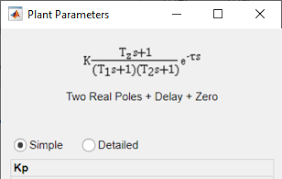过程模型
具有静态增益、时间常数和输入/输出延迟的低阶传递函数模型
过程模型广泛应用于描述许多行业的系统动态特性,并适用于各种生产环境。这些模型的优点是简单,支持传输延迟估计,并且模型系数可以很容易地解释为零极点。
一个简单的 SISO 过程模型具有增益、时间常数和传输延迟。
这里,Kp 是比例增益,Tp1 是实极点的时间常数,Td 是传输延迟(死区时间)。
在 System Identification Toolbox™ 中,idproc 模型提供了过程模型结构,可以表示最多具有三个极点和一个零点的过程模型。
有关详细信息,请参阅What Is a Process Model?
App
| 系统辨识 | 从测量数据辨识动态系统模型 |
实时编辑器任务
| 估计过程模型 | 使用实时编辑器在时域或频域中估计单输入单输出 (SISO) 系统的连续时间过程模型 |
函数
主题
过程模型基础知识
- What Is a Process Model?
A process model is a simple continuous-time transfer function that describes linear system dynamics in terms of static gain, time constants, and input-output delay. - Data Supported by Process Models
Use regularly sampled time-domain and frequency-domain data, and continuous-time frequency-domain data.
估计过程模型
- Estimate Process Models Using the App
Specify model parameters and estimation options to use for estimating a process model. - Identify Low-Order Transfer Functions (Process Models) Using System Identification App
Identify continuous-time transfer functions from single-input/single-output (SISO) data using the app. - Estimate Process Models at the Command Line
Estimate first-order process models with fully free parameters and with a combination of fixed and free parameters. - Estimating Multiple-Input, Multi-Output Process Models
Specify whether to estimate the same transfer function for all input-output pairs, or a different transfer function for each pair.
设置过程模型选项
- Process Model Structure Specification
Configure the model structure by specifying the number of real or complex poles, and whether to include a zero, delay, and integrator. - Disturbance Model Structure for Process Models
Specify a noise model. - Specifying Initial Conditions for Iterative Estimation Algorithms
Specify how the algorithm treats initial conditions for estimation of model parameters.
